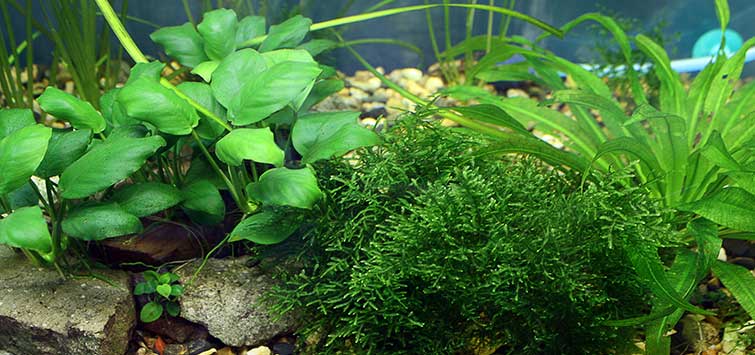The Planted Tank: The Secrets of the Madagascar Lace Plant
The Planted Tank: The Secrets of the Madagascar Lace Plant
Author: Ted Coletti
Hello, I’m Rhonda Wilson.
Actually, I’m just kidding—it’s me, Ted Coletti! Y’know, the guy from a few columns up the road? Although David and Al wouldn’t let me wear Rhonda’s dress for my bio pic, citing unspecified “insurance reasons,” I still wish you all a merry April Fools!
I’ve known Rhonda since the early days of the Internet, the pre-browser early 1990s (can you believe that was over 15 years ago?). Back then we were both young punks on a FISHNET forum. Actually, I was the New York punk, Rhonda was the friendly, generous, and innovative Southwest hobbyist she still is today. “After changes upon changes we are more or less the same,” as Paul Simon sang, though I like to believe Rhonda’s good nature has rubbed off on me over the years.
My first interaction with Rhonda was when she sent me a box of surplus Xiphophorus variatus, which she couldn’t bear to discard or place in an unwanted home. Upon opening the box I quickly fed them to my Thorichthys meeki. We’ve been fast friends ever since. Granted, she didn’t talk to me for about 10 years, but I didn’t take that personally.
Rhonda is a former Chairperson of the American Livebearer Association. Many of you know that before livebearers my hobby focus was planted and biotope aquaria. So we thought April Fools month would be a good time to switch teams for an issue.
My guest columnist topic is an easy one. It is the pride of my home aquaria. No, it’s not a livebearer, it’s my Madagascar lace plant!
APONOGETON MADAGASCARIENSIS
The Madagascar lace needs little introduction. It is unique among aquatic plants. Indeed, it stands out amongst all rooted plants. Its fame (and common name) comes from its leaf structure, or lack thereof. As the accompanying photos from my own stock demonstrate, the most striking feature of the Madagascar lace is its “skeletonized”—or fenestrated—leaves. Sprouting from a tuberous rhizome that is mistaken for a bulb in some forms, Aponogeton madagascariensis forms a rosette of leaves that vary in length from barely 2 inches to nearly 3 feet long, depending on the variety. If the discus is the king of the aquarium fishes, then the Madagascar lace is the queen of aquarium plants!
The Madagascar lace was in such high demand when they were first introduced after World War II that their numbers were soon decimated and extinction was feared. Tissue cultivation and proper propagation and division have helped reverse this situation, thankfully. It is still a rare plant to come across and sports a hefty price tag when it does.
There are many varieties of Aponogeton madagascariensis, which at one time were given separate species status. Dr. Paul Loiselle, the conservationist and famed aquarist for the New York Aquarium, told me that he has seen many intermediate forms of the plant in nature, from nearly solid leaves to radical fenestration.
H. W. E. van Bruggen has written extensively on the Aponogeton and describes three primary varieties cultivated for the home aquarium. Aponogeton madagascariensis var. madagascariensis is the narrow-leaved form where the lattice structure of the leaves is not fully fenestrated and the cavities take on a somewhat rounded shape. This appears to be the form I acquired at last year’s American Livebearer Association Convention as a very generous gift from a very generous man, the legendary Jim Langhammer of Detroit. “Hammer” received this plant from a European hobbyist and has had exceptional good fortune in propagating it (granted, Hammer’s skill in all things aquatic is well-known). This form has more of a rhizome tuber that can be cut to create more plants.
The other Madagascar laces enjoyed in the hobby are Aponogeton madagascariensis var. henkelianus andvar. major. In this variety the leaf truly is just veins, creating an amazing skeletonized structure that is quite striking to any observer. My experience has been with the major variety, which sports a consistent fenestration. The henkalianus form possesses transversal veins and displays a slightly more irregular lattice.
HABITAT
As its name suggests, the lace plant hails from the massive island of Madagascar, off the southeast coast of Africa. It has been naturalized in Mauritius as well. Early descriptions advised a need for calm water, probably due to the misleadingly delicate appearance of its leaves. We now know that the Madagascar lace leaves are well-suited to even fast-flowing rivers and that it is only rarely encountered in standing water. But the many populations on the island have adapted to varying conditions, in biotopes of all kinds. This probably created the early critiques of the plant as difficult, as specimens from varying habitats were not given the special care required to adapt to aquarium conditions.
In all of these biotopes, however, one attribute has been observed: the Madagascar lace plant is a true aquatic. It does not, like most of our other aquarium plants, undergo an emersed form, nor does it require a “drying-out” period like some other Aponogeton. The latter is a critical observation, since most aquarium Aponogeton bulbs require a “resting phase,” usually out of the water in a moist condition. The failed application of this practice to early Madagascar lace imports probably further compounded its reputation as a “difficult” aquarium plant. Coincidently, it was around this same time that some other African imports, the Rift Valley cichlids, were given the same reputation. But once the hobby discovered their specific water and aquascape needs, they became an easy fish to maintain and breed. The rest of this column will attempt to accomplish the same for the elusive Madagascar lace.
SECRETS TO SUCCESS
My experience with Aponogeton madagascariensis var. major and Langhammer’s withvar. madagascariensis demonstrate that this is not the impossible plant reported by hobbyists. A few requirements are all that is needed to enjoy this “king of show plants.” They challenge some of the conventional wisdom of aquarium plants, but they work:
Use a warm-water resting phase. That’s right, “warm water.” Those of you versed in the care of Aponogeton bulbs are well aware of the cool-water resting phase most species require in order to keep them going year after year. Madagascar lace look their worst during summer, when they drop most of their leaves and grow small new ones, if any. But this is the natural order of things for this plant. Come fall, new foliage will emerge, bigger and with more leaves from the rosette. Albert Greenberg, the late aquarium plant legend, farmer, and philanthropist, revealed this secret to TFH readers back in the 1960s, but it appears to have been lost to the modern plant hobby.
Use cooler water for the other seasons. When not in its summer resting phase, maintain your Madagascar lace in temperatures from the 60s to mid-70s. High 60s to low 70s is ideal.
Keep the bulb emersed. Do not take it out of the aquarium for its rest phase like you would do with other Aponogeton bulbs. Let it remain in the substrate. Some hardy cryptocorynes, which enjoy very similar conditions to the Madagascar lace, are good companion plants to keep the substrate fresh.
Try low to moderate lighting. Most Aponogeton grow under lower light than other aquarium plants. One of the problems with the new high-efficiency aquarium lights is that they are so much brighter than the more common, old-fashioned standard fluorescent strips. Bright light appears to trigger dormancy and sometimes pesky algae growth in the “windows” of the Madagascar lace. Using the standard fluorescent tubes (T-12 and T-8) as a guide, I prefer 1 to 2 watts per gallon.
Plant the rhizome tuber/bulb half in the substrate, leaving the half with the growing tip above the substrate. You may need to plant the tuber deeper in the substrate for a few weeks until the roots are established, to prevent it from floating to the surface. You can tug it up into place after it is rooted; this may interrupt leaf growth for a while.
Use a rich but clean substrate. A deep substrate is not required. One to just under 2 inches works well and will assist in preventing stagnation. With low light, you get slow growth and it is here that a thin gravel bed is key to prevent stagnation. Remember: we don’t gravel vac the planted aquarium! Try some laterite or clay-based medium, cut with some swimming pool filter sand or fine gravel, and a fertilizer tablet.
Provide water flow via a power filter. Water circulation is especially important for the high tank required by a healthy Madagascar lace.
Provided these conditions, the Madagascar lace will prosper in soft/acidic to moderately hard/alkaline water. If you are fortunate, you may witness flower and seed development. When the seeds are shed they are covered in a thin jacket where they float for a day or two. You can harvest the seed at this point and attempt to propagate it in a small bowl. I have not found the Madagascar lace to be as free-flowering as the dry Aponogeton bulbs commonly sold in blister packs in pet departments.
Hmm…a plant that likes cool temperatures, low light, and changing temperatures. Sounds like a great companion for a goodeid tank! And with that, my friends, I will see you next month back at “Livebearers Unlimited.”
I hope Rhonda vacuumed before she left.

.png?h=595&iar=0&w=2781&hash=5FD5E69473BCC22199FBFA2FB71B6033)



